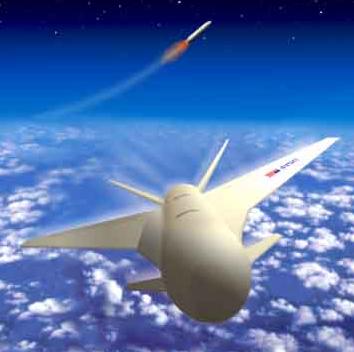Original URL: https://www.theregister.com/2009/05/13/usaf_rbs_ploy/
US airforce looking at winged-rocket booster 'X-plane'
'VTHL': Cheaper than disposables, proper spaceplanes
Posted in Science, 13th May 2009 12:48 GMT
The US Air Force has announced that it is interested in a "Reusable Booster System" (RBS) - a combination of rocket and aeroplane which could replace the first stage of existing orbital launch stacks. After the upper stages separated and carried on into space, the winged RBS would glide down to a winged landing for refuelling and subsequent re-use.

Up, up and... back down
The RBS plans are the subject of a "concept options maturation study" announced this week by the Air Force Research Laboratory, aimed at an expected "integrated demonstration project" in future. In outline, the air force boffins set out what they're interested in doing:
Studies have suggested that a Reusable Booster System (RBS) could reduce the cost of space transportation by significantly reducing the amount of flight hardware expended to achieve orbit while maintaining a moderate vehicle stack weight and associated development cost ... The architecture consists of a reusable booster that can be integrated with a family of expendable stages to support the full range of [military] payloads from suborbital missions to operationally responsive payloads to heavy-lift missions.
There are loads of different ideas around for re-usable first stage boosters. It's already possible to use a modified jet airliner, for instance, to lift a small satellite-carrying rocket rocket up to launch height and speed. There's a similar scheme to launch small satellites from the Virgin Galactic "mothership" jet.
In other ploys, the lower stages might include rocket engines of their own, or super-high-tech hypersonic air-breathing engines - scramjets or things even more exotic. There are even ambitious plans which might one day produce a single craft able to reach orbit from a runway takeoff.
Alternatively you might build something relatively prosaic and achievable like a normal rocket booster which lifts off vertically and then tips over to fly back down like a plane after saying goodbye to the throwaway upper stages and payload. This, it seems, is what the airforce lab boys have in mind. They also have firm ideas as to what kind of rocket they want:
Cheaper than anything good, gooder than anything cheap?
Specifically, the current technology objectives are derived from an unmanned, vertical take-off and horizontal landing (VTHL), rocket-powered, reusable booster concept. During normally expected operations of this concept, the reusable booster uses its rocket engines to autonomously perform a post-staging maneuver (i.e., rocket-back) which orients and positions the booster for a gliding landing near the launch site. This concept includes an integral tank and airframe that bears both internal pressure and flight and ground loads. The concept is powered by pump-fed, LOx-HydroCarbon rocket engines.
That said, "responses need not be limited to the subset of the RBS concept space described in the previous paragraph." But the air force does want to see designs using an existing main engine, rather than some kind of expensive new thruster design.
It seems that not only the air force Research Laboratory but also the service's Space and Missile Center and Space Command are in favour of the RBS concept. This presentation (ppt) says that the RBS is seen as the best way to reduce overall space launch costs in the US military, and perhaps for civil space missions too. In terms of complexity and difficulty the RBS idea falls between today's expendable boosters (low development costs but very pricey in use) and plans for completely-reusable launch systems, probably involving stacked rocket-gliders with a shuttle-style orbiter spaceplane on top. The latter would be extremely expensive to develop and not especially cheap to use, as much of the mass fired into orbit would consist of orbiter/lander rather than payload.
By contrast, the RBS combo of reusable winged lower stage plus expendable upper stage(s) is seen as offering a 50 per cent overall saving and useful flexibility. It would be possible, for instance, to throw a bigger upper stack and large payload up to kickoff point by strapping paired RBS rocketplanes to either side of its base.
The space-command people see serious development starting on the RBS plans early next decade. Reportedly, a subscale "X-plane"* demonstrator might fly before 2020. ®
Bootnote
* Particularly arse-kicking US military winged testbed aircraft have traditionally tended to get an X-plane designation. Examples include the famous X-1 (broke the sound barrier) and X-15 (manned flight at Mach 6+). The X-planes rather petered out in the Apollo/Shuttle era, but ambitious military wing-ship plans still occasionally seek to recall the glorious past.